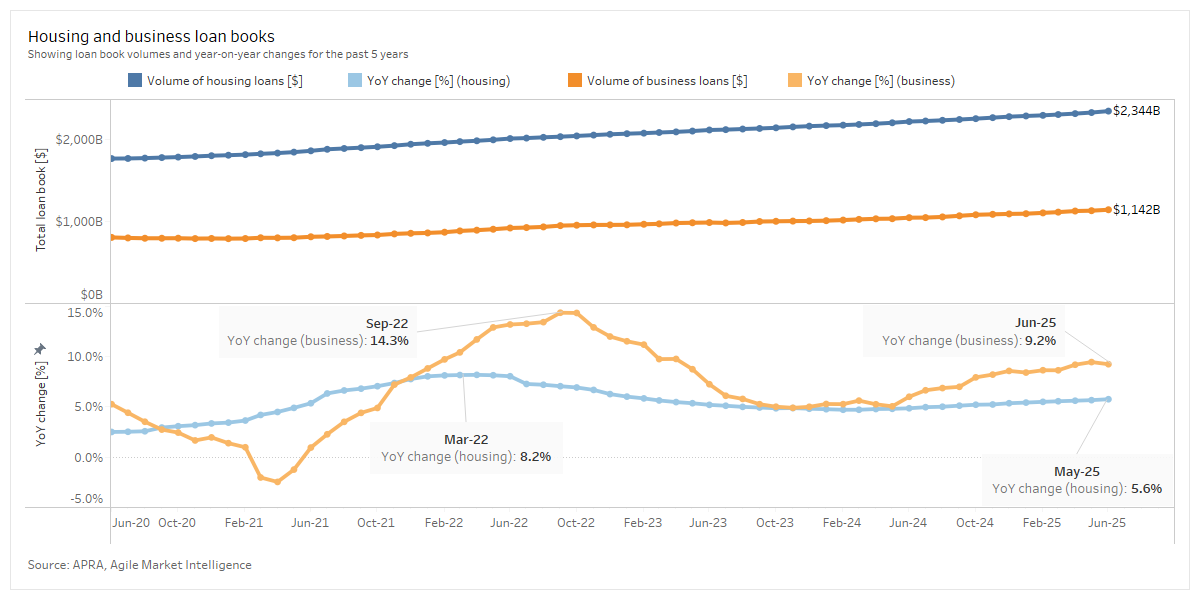Business lending up 9.2% year-on-year in June, opening largest gap with housing loans since 2022
The Australian Prudential Regulation Authority (APRA) has released its monthly ADI statistics report for June 2025. APRA’s latest figures show non-financial business lending is expanding nearly twice as fast as housing credit, signalling renewed appetite for corporate borrowing. Agile Market Intelligence has plotted the publicly available APRA data to visualise the loan volumes and year-on-year changes in business and housing loans.
Key stats you need to know
- Loans to non-financial businesses totalled $1.14 trillion in June 2025, up 9.2% year-on-year.
- Housing loans reached $2.34 trillion, growing at a slower 5.6% year-on-year.
- The growth gap between business and housing lending is now the widest since September 2022.
Business lending accelerates
- The business loan book hit $1.14 trillion in June 2025, the highest on record.
- Annual growth in business lending was 9.2%, compared to just 5.6% for housing.
- Growth has picked up steadily since late 2023, reversing a period of sluggish expansion.
- This marks the strongest pace of business loan growth since the 14.3% peak in September 2022.
Business lending is once again outpacing mortgages, showing that corporates are willing to borrow and invest despite elevated interest rates. The rebound suggests stronger demand for working capital, investment and refinancing.
“Near double-digit growth in business lending tells us confidence is returning, a sign of resilience in the corporate sector,” said Michael Johnson, Director at Agile Market Intelligence.

Housing loans steady but slowing
- Housing credit balances stood at $2.34 trillion in June 2025, more than double of business lending.
- Annual growth slowed to 5.6%, compared to 8.2% at its March 2022 peak.
- Mortgage growth has been stuck in the 4-6% range for the past two years.
Housing remains the largest driver of bank balance sheets, but its pace has softened, underscoring a more cautious household borrowing environment. The market remains steady, but lacks the momentum seen in business lending.
“Mortgages are stable, but growth has settled to a slower pace than the corporate sector. It still keeps balance sheets steady but doesn’t deliver acceleration,” Johnson noted.
Divergence highlights shifting dynamics
- The growth gap between business (9.2%) and housing (5.6%) lending reached almost four percentage points in June 2025.
- This is the widest divergence since Sept 2022, when business lending surged to 14.3% (housing grew 7.0%).
- Unlike that short-lived spike, the current uplift appears more gradual and sustained.
The divergence between business and housing loans reflects different borrower behaviours where corporates are leveraging for growth and households remain cautious. Business lending is emerging as the growth driver today, while housing holds steady as the foundation, shifting the structure of the credit markets.
“There is now a contrast in behaviour, households are being cautious, while businesses are leaning in. For lenders, that means the growth story is shifting away from mortgages and toward business finance,” Johnson said.
About the data
Figures in this article were drawn by Agile Market Intelligence from APRA’s monthly ADI statistics to June 2025. The dataset covers total housing loans and loans to non-financial businesses across authorised deposit-taking institutions. Year-on-year changes are calculated as of June 2025, with historical figures included for context
Agile Market Intelligence also conducts the Broker Pulse: Commercial Lending report, a community-driven benchmarking initiative capturing the experiences of commercial and asset finance brokers across Australia. The latest edition captures experiences for applications submitted throughout July 2025, with the survey conducted between 1st to 22nd August 2025. The report includes data across asset finance, business loans, and commercial mortgages, and is conducted by Agile Market Intelligence in partnership with the Commercial & Asset Finance Brokers Association (CAFBA).








.svg%402x.png)








.png)
















